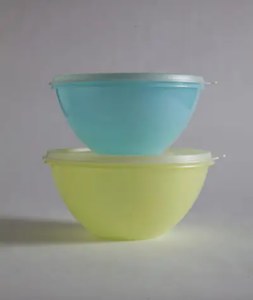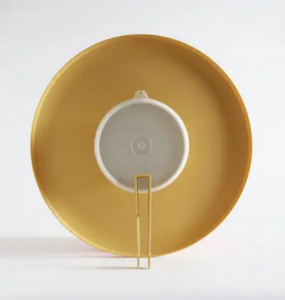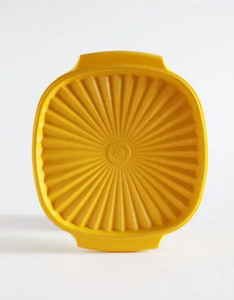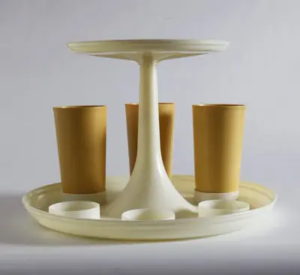Every 1.5 seconds, somewhere on the planet, a Tupperware party is thrown; nearly $2.6 billion dollars’ worth of Tupperware is sold annually in more than 100 markets worldwide.
By the numbers alone, the kitchenware company that New Hampshire inventor Earl Tupper founded in 1946 displays its remarkable reach. But take a closer look at Tupperware’s trajectory, and you can chart the past half-century of kitchen culture in the U.S. and beyond.
Vintage Tupperware Salt & Pepper Shakers Hourglass 6″ Tall

The Birth of the Bell Tumbler
Tupperware products actually had their inception not in the kitchen but on the battlefield. Earl Tupper had worked for DuPont developing the country’s first plastics for use in World War II radars. Around 1942, casting about for nonmilitary uses for the flexible material, he created an injection-molded polyethylene cup, which he called the Bell Tumbler. It was introduced to the market in 1946, marking the beginning of the Tupperware revolution.
The Versatile Wonderlier Bowl

Along with the Bell Tumblers, Tupperware introduced the sealed, nesting Wondelier Bowls. With an 80 percent increase in home refrigeration in the 1940s, food storage proved to be the perfect application for Tupper’s durable polymer. The stackable containers organized the fridge and spoke to a growing interest in hygiene; their patented “burping” seal – its name echoing a primary maternal task of 1940s housewives – kept foods fresh.
Adapting to the Suburban Lifestyle

Tupperware fit the changing American lifestyle in other ways, too. From 1947 to 1953, America’s suburban population grew by 1.3 million people per year, and the use of Tupperware spread with the suburbs, aided by a sales method matched to the postwar era’s renewed domesticity: the Tupperware Home Party, an all-female gathering centered on product demonstrations. As Americans entertained more at home, Tupperware developed hostess-friendly items like the bowl-and-platter Dip ‘N Serve Tray.
Appealing to the Upwardly Mobile

As early as 1947, Tupperware was targeting upwardly mobile consumers with lines like the pastel Millionaire Collection, displayed and sold at the time in department stores. This item, which has an atomic-era style to it, incorporated a small toothpick holder at the top of the stand between the shakers, catering to the growing desire for stylish and functional kitchenware.
The Pie Taker and the Birth of a Kitchen Icon

In the 1950s, as backyard barbecues and picnics grew in popularity, Tupperware introduced the Pie Taker, a sealed round storage container designed to make transporting homemade desserts to family gatherings a breeze. This ingenious design laid the foundation for Tupperware’s enduring legacy, as the brand recognized the need for practical, yet stylish, solutions to the everyday challenges faced by home cooks.
The Servalier Canister: Capitalizing on the Rise of Packaged Foods
The Servalier line of storage canisters, introduced in 1962, showcased Tupperware’s keen understanding of the shifting trends in the food industry. With their nested design and decorative flower emblems, these canisters were designed to accommodate the growing popularity of packaged foods, solidifying Tupperware’s position as a trusted partner in the modern kitchen.
The Astro Bowl and the Lasting Legacy of Tupperware’s Air-Tight Seals

One of the hallmarks of Tupperware’s innovation is its air-tight seals, a feature that can be seen in products like the Astro Bowl, introduced in 1972. These seals, designed with a simple push-down mechanism, have become synonymous with the brand, ensuring the freshness and longevity of the stored contents.
As the decades passed, Tupperware continued to evolve, introducing specialized products to meet the demands of an ever-changing global landscape. The Crisp It lettuce keeper, first introduced in the 1960s, was designed to help greens retain their freshness and color, reflecting the brand’s commitment to addressing the practical concerns of home cooks.

Tupperware’s expansion into international markets has also shaped its product development, leading to the creation of items like the Kimchi Keeper for Korea and the ventilated CheeSmart cheese storer for Europe. These localized products demonstrate the brand’s understanding of the diverse culinary preferences and storage needs of its global customer base.
In response to the growing need for space-saving solutions, particularly in smaller kitchens around the world, Tupperware introduced the Keep Tabs containers in 2009. These nesting containers, available in sizes as small as five ounces, have become a hit in countries like Mexico and Uruguay, where every bit of saved space counts.
Tupperware’s commitment to innovation has also extended to addressing pressing environmental concerns, as evidenced by the introduction of the Nature Nano Water Filter in 2010. This countertop filtration system helps to clean industrial pollutants from tap water, reflecting the brand’s dedication to providing sustainable solutions for the modern household.

Throughout its storied history, Tupperware has consistently demonstrated its ability to adapt to the changing needs of its customer base, reinventing itself time and time again. From the iconic Pie Taker to the cutting-edge Nature Nano Water Filter, the brand’s products have become synonymous with quality, functionality, and a relentless pursuit of innovation.
As the world continues to evolve, Tupperware remains poised to lead the charge in the kitchenware industry. With a focus on sustainability and a commitment to leveraging the latest technological advancements, the brand is well-positioned to meet the demands of the 21st-century consumer, cementing its status as a kitchen icon for generations to come.
Tupperware’s enduring appeal lies in its ability to seamlessly blend practical functionality with stylish design, creating products that have become an integral part of the modern kitchen. As the brand continues to innovate and adapt, its legacy as a trusted partner in the ever-evolving world of home cooking is secure, ensuring that Tupperware will continue to be a staple in households around the globe.





